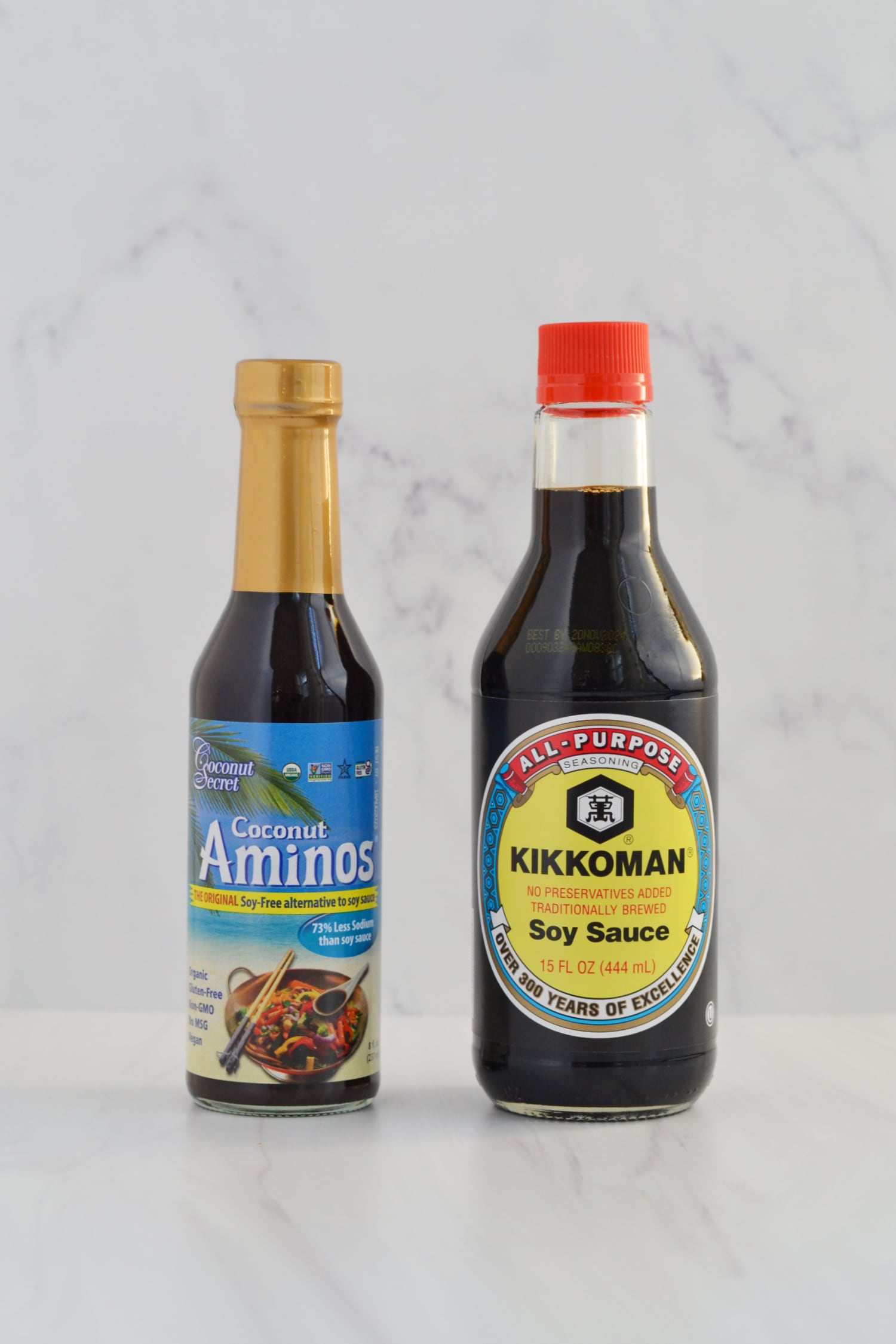This post may contain affiliate links. Please read our disclosure policy.
If you’re wondering what the difference is between coconut aminos vs soy sauce, you’re in the right place!

With the explosion of soy sauce alternatives, there’s now plenty of options to choose from at the grocery store, and things can get confusing in a hurry. The most prominent and widely used soy sauce alternative is coconut aminos, mostly because of the ingredients and flavor.
While both soy sauce and coconut aminos are fermented and add umami (savoriness) to recipes, they each have a unique flavor because of what they’re fermented from. There’s also a slight difference in overall sodium content, which is really important when it comes to substituting coconut aminos for soy sauce in recipes.
So what exactly is the difference between coconut aminos vs soy sauce? Let’s break it down!
Jump to:
Difference Between Coconut Aminos vs Soy Sauce
To put it simply, the difference between coconut aminos and soy sauce is the flavor and sodium content. Coconut aminos has a milder, sweeter flavor, and less sodium than soy sauce. Soy sauce has a richer flavor, and about three times as much sodium as coconut aminos. Coconut aminos is also gluten free as it’s made from the sap of the coconut palm, while soy sauce is traditionally made from fermented soybeans and wheat.
Bottom line: Coconut aminos is a gluten-free and soy-free alternative to soy sauce that has a milder flavor and less sodium.
What is Coconut Aminos?
Coconut aminos is a savory seasoning sauce made from the fermented sap of coconut palm. After the coconut sap is extracted, it gets stored and ages. During this time, it ferments due to the natural sugars present within it.
Coconut aminos is a milder version of soy sauce that has less salt. It has lots of umami and has many uses in recipes. Don’t worry, even though coconut aminos is made from coconut sap, it doesn’t taste anything like coconut.
What is Soy Sauce?
Soy sauce is a flavorful ingredient often used in Asian cooking and beyond: it’s made from fermented soybeans, wheat, and salt. It generally involves a two-stage fermentation process and requires added fermentation agents. Chinese in origin, it contains strong umami flavor and is often used in sauces, stir-fries, marinades, and more.
While there are many different types of soy sauce—dark, light, gluten free, and even some with reduced sodium—the most popular type of soy sauce in the US is dark soy sauce.
Is Coconut Aminos Healthy?
While some claim coconut aminos has health promoting properties, there is no research to back up these claims. Coconut aminos is not rich in nutrients, and there is no evidence that coconut aminos has any health benefits. Coconut aminos may be a healthy alternative to soy sauce because:
- There is no soy or gluten in coconut aminos, which are two common allergens.
- Traditional soy sauce contains anywhere from 280 – 320 mg of sodium per teaspoon, while coconut aminos has 90 mg of sodium per teaspoon.
- Soy is often genetically modified and not organic, whereas coconut aminos is typically organic (less pesticide exposure) and non-GMO.
Can I Substitute Coconut Aminos For Soy Sauce?
Yes! You can substitute coconut aminos for soy sauce and vice versa, just make sure to adjust the salt in your recipe. Here’s how to substitute both in recipes:
- Substitute coconut aminos for soy sauce: You can use coconut aminos in a 1:1 ratio for soy sauce in recipes. Because coconut aminos has less sodium, you may want to add a pinch of salt or more to taste.
- Substitute soy sauce for coconut aminos: Because coconut aminos has a third of the sodium as soy sauce, you need to reduce the salt in the recipe or use less soy sauce. For example, if a recipe calls for 3 tablespoon coconut aminos, use 1 tablespoon soy sauce and add 2 tablespoons warm water to keep the the same sodium content and liquid volume. For other alternatives to coconut aminos, check out the best coconut aminos substitutes.

Other Soy Sauce Alternatives
Two other common soy sauce alternatives are liquid aminos and tamari. Here’s how they differ from both coconut aminos and soy sauce:
- Liquid aminos is a dark, salty seasoning sauce similar to soy sauce. It is gluten free but not soy free. It’s made by treating soybeans with an acidic chemical solution that breaks down the soy protein, then the acid is neutralized. Liquid aminos typically has the same amount of sodium as traditional soy sauce.
- Tamari is a Japanese seasoning sauce made from fermented soybeans: it’s typically gluten free but not soy free. It’s darker, richer, and tastes slightly less salty than traditional soy sauce. It contains about 300 mg of sodium per teaspoon.
While liquid aminos and tamari can generally be swapped in a 1:1 ratio for soy sauce, if you want to substitute liquid aminos or tamari for coconut aminos, you need to reduce the salt in the recipe or use less since both have more sodium.
Recipes with Coconut Aminos
If you’re ready to taste the difference, give coconut aminos a try with some tried and true recipe! Here are a few of my favorites:
- Healthy Orange Chicken (with orange chicken sauce)
- Sheet Pan Steak Fajitas
- Breakfast Fried Rice
- Beef and Broccoli Stir Fry
- Egg Roll in a Bowl
The Bottom Line
Soy sauce and coconut aminos are two condiments that add a rich flavor to a variety of dishes. But, they differ quite a bit in sodium content and other ingredients.
If you’ve been curious about the differences between coconut aminos vs soy sauce, I hope this helps answer some of your questions! And if you have any creative or favorite ways to use coconut aminos, please share!




